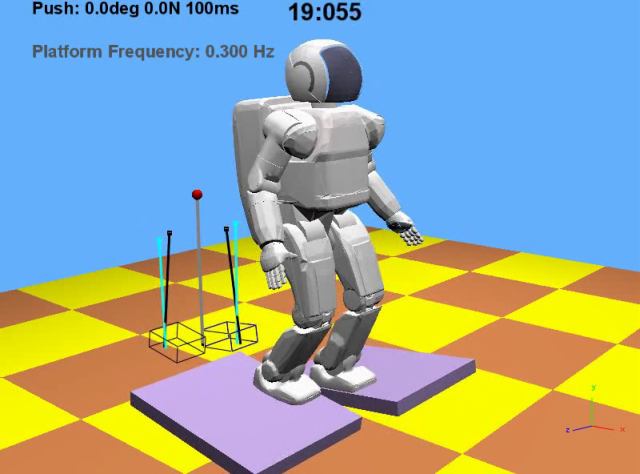Humanoid robots, with their ambitious aim to mimic human movements and interact with the world like people, face a fundamental challenge: balance. Unlike wheeled or tracked robots, navigating and performing tasks in uneven or dynamic environments requires a delicate balance control system. This article explores the intricacies of humanoid robot balance algorithms, dissecting their key components and highlighting their crucial role in enabling these fascinating machines to stand upright and move gracefully.

Understanding the Balance Equation:
Before delving into the algorithms, it’s essential to understand the fundamental principles governing balance. A robot’s stability hinges on the delicate interplay between its center of mass (COM), base of support (BOS), and applied forces.
- Center of Mass: The point at which the robot’s total mass is evenly distributed.
- Base of Support: The area on the ground that the robot’s feet or other contact points occupy.
For a robot to maintain balance, its COM must remain within its BOS. Achieving and maintaining this equilibrium requires continuous adjustments based on internal forces generated by the robot’s actuators and external forces acting upon it due to gravity, ground contact, and environmental disturbances.
Core Balance Algorithm Components:
Developing robust balance control algorithms involves a complex interplay of several key components:
- Sensor Fusion:
Humanoid robots rely on an array of sensors to perceive their surroundings and internal state. These include:
- Inertial Measurement Units (IMUs): Measuring acceleration and angular velocity to determine the robot’s orientation and movement.
- Joint Position Sensors: Providing feedback on the angles of each joint in the robot’s body.
- Force/Torque Sensors: Measuring the forces and torques exerted by the robot’s contact points with the ground.
Effectively fusing data from these sensors provides a comprehensive understanding of the robot’s dynamic state.
- Model-Based Prediction:
Sophisticated mathematical models are used to predict the robot’s future motion and potential balance disruptions. These models often incorporate:
- Dynamic Simulation: Simulating the robot’s movement based on its physical parameters, joint torques, and applied forces.
- Inverse Kinematics: Determining the required joint angles to achieve desired poses.
Accurate predictions allow the algorithm to anticipate balance challenges and proactively initiate corrective actions.
- Feedback Control:
Feedback control mechanisms fine-tune the robot’s movement in real-time based on sensor data and predicted state deviations. Common techniques include:
- Proportional-Integral-Derivative (PID) Control: Precisely regulating the activation of actuators to maintain stability.
- Model Predictive Control: Optimizing actuator commands over a sequence of future time steps to achieve desired balance and motion goals.
- Adaptive Learning:
Many advanced algorithms incorporate machine learning techniques to adapt to changing environments and refine balance control strategies.
Reinforcement Learning: Training the robot to perform balancing tasks through trial and error, rewarding successful balance and penalizing instability.
Supervised Learning: Utilizing labeled data of successful balance instances to train a model that can predict and correct for potential imbalances.
Classifying Balance Algorithms:
Various approaches exist for implementing balance control in humanoid robots:
- Reactive Control:
Algorithms that respond directly to immediate sensor data, making quick adjustments to prevent immediate loss of balance. These are often simpler but less robust in dealing with complex or unpredictable disturbances.
- Proactive Control:
Algorithms that anticipate potential balance issues based on predicted future states and proactively adjust the robot’s posture and movement to stay stable. These are generally more sophisticated and effective for complex tasks.
- Hierarchical Control:
A multi-layered approach where simpler reactive controllers handle immediate balance needs, while higher-level controllers manage overall movement planning and balance maintenance during complex tasks.
Challenges and Future Directions:
Despite significant progress, humanoid robot balance control remains a challenging research area. Key obstacles include:
Robustness to Uncertainty: Real-world environments are inherently unpredictable, requiring algorithms that can handle sensor noise, dynamic disturbances, and unforeseen obstacles.
Computational Efficiency: Implementing complex control algorithms in real-time can be computationally demanding.
Energy Efficiency: Maintaining balance consumes energy, impacting the robot’s operational lifespan.
Future research will focus on developing more robust, efficient, and adaptive algorithms, incorporating advancements in machine learning, sensor technology, and bio-inspired control strategies.
Looking Ahead:
Humanoid robot balance algorithms are at the forefront of robotics research, paving the way for robots that can seamlessly navigate our world. As these algorithms continue to evolve, we can expect to see more capable, agile, and human-like robots interacting with us in increasingly sophisticated ways.
FAQ:
1. Why is balance important for humanoid robots?
Balance is essential for humanoid robots to stand upright, walk, and perform tasks in a stable and natural manner. It allows them to interact with their environment safely and efficiently.
2. What types of sensors are used for balance control?
Humanoid robots use a combination of sensors, including IMUs, joint position sensors, and force/torque sensors, to gather information about their orientation, joint angles, and contact with the ground.
3. How do machine learning algorithms improve balance control?
Machine learning algorithms can analyze vast amounts of sensor data to learn patterns and make predictions about potential balance issues. They can then adapt control strategies in real-time to maintain stability.
4. What are some of the challenges in developing balance control algorithms?
Challenges include handling real-world uncertainties, ensuring computational efficiency, and minimizing energy consumption.
5. How will balance control contribute to the future of robotics?
Advancements in balance control will enable humanoid robots to perform more complex and human-like tasks, leading to wider applications in fields like healthcare, manufacturing, and domestic assistance.
Conclusion:
Humanoid robot balance control is a complex and ever-evolving field. Through the integration of sophisticated algorithms, advanced sensors, and machine learning techniques, researchers are continuously pushing the boundaries of what’s possible. As these technologies mature, we can expect to see increasingly capable and agile humanoid robots seamlessly integrating into our world.
Closure
Thus, we hope this article has provided valuable insights into Maintaining Equilibrium: A Deep Dive into Humanoid Robot Balance Algorithms. We hope you find this article informative and beneficial. See you in our next article!